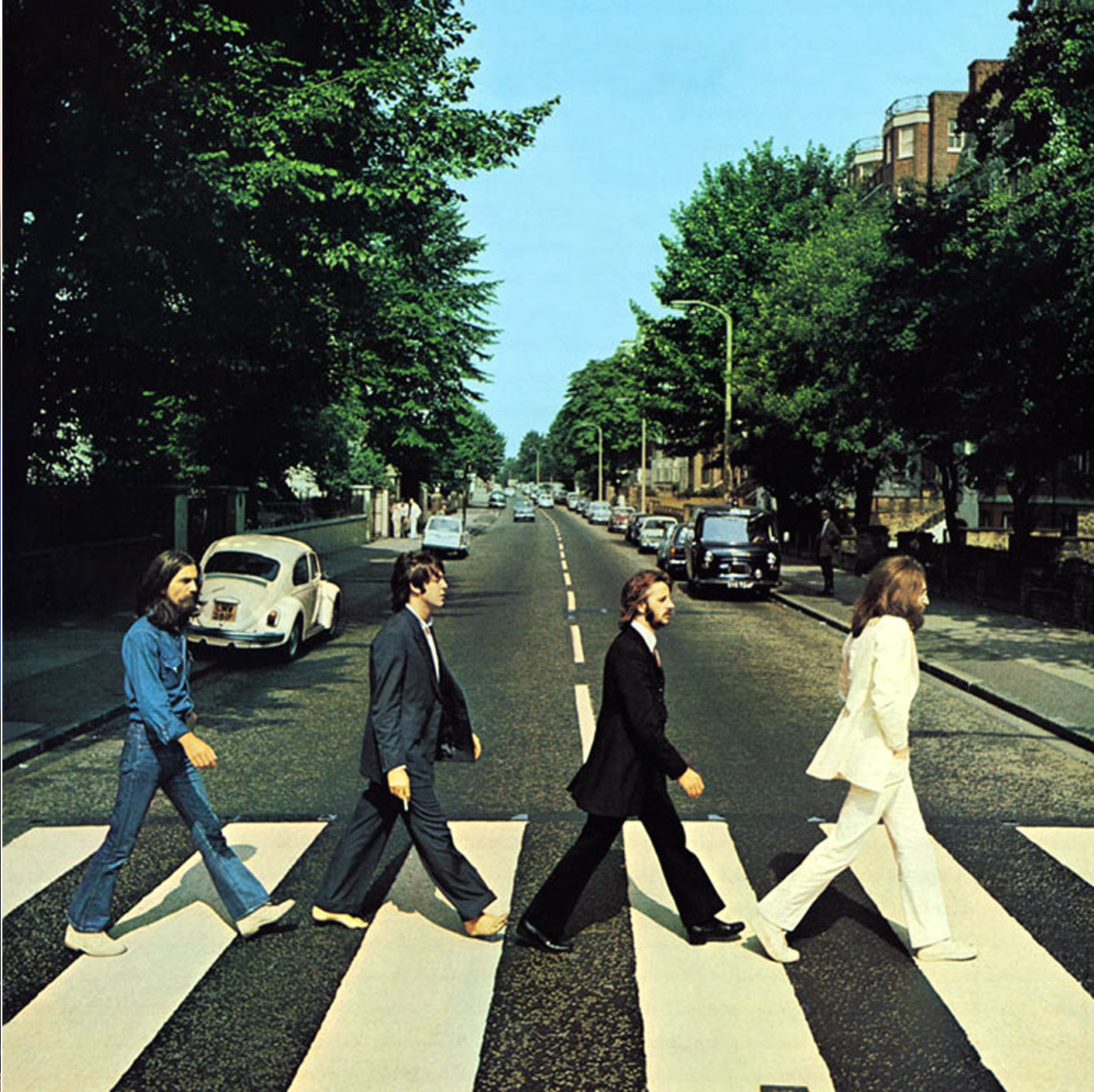
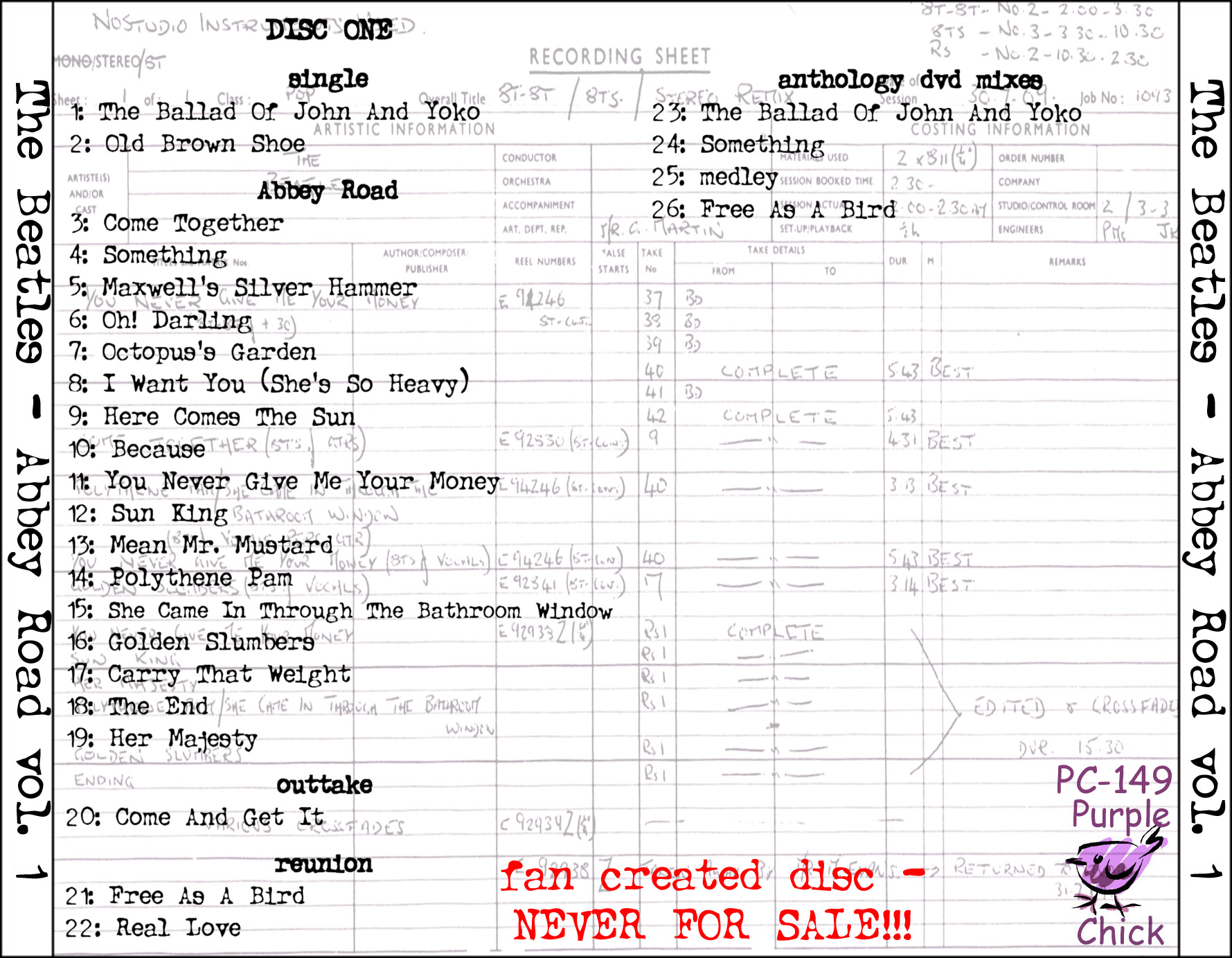
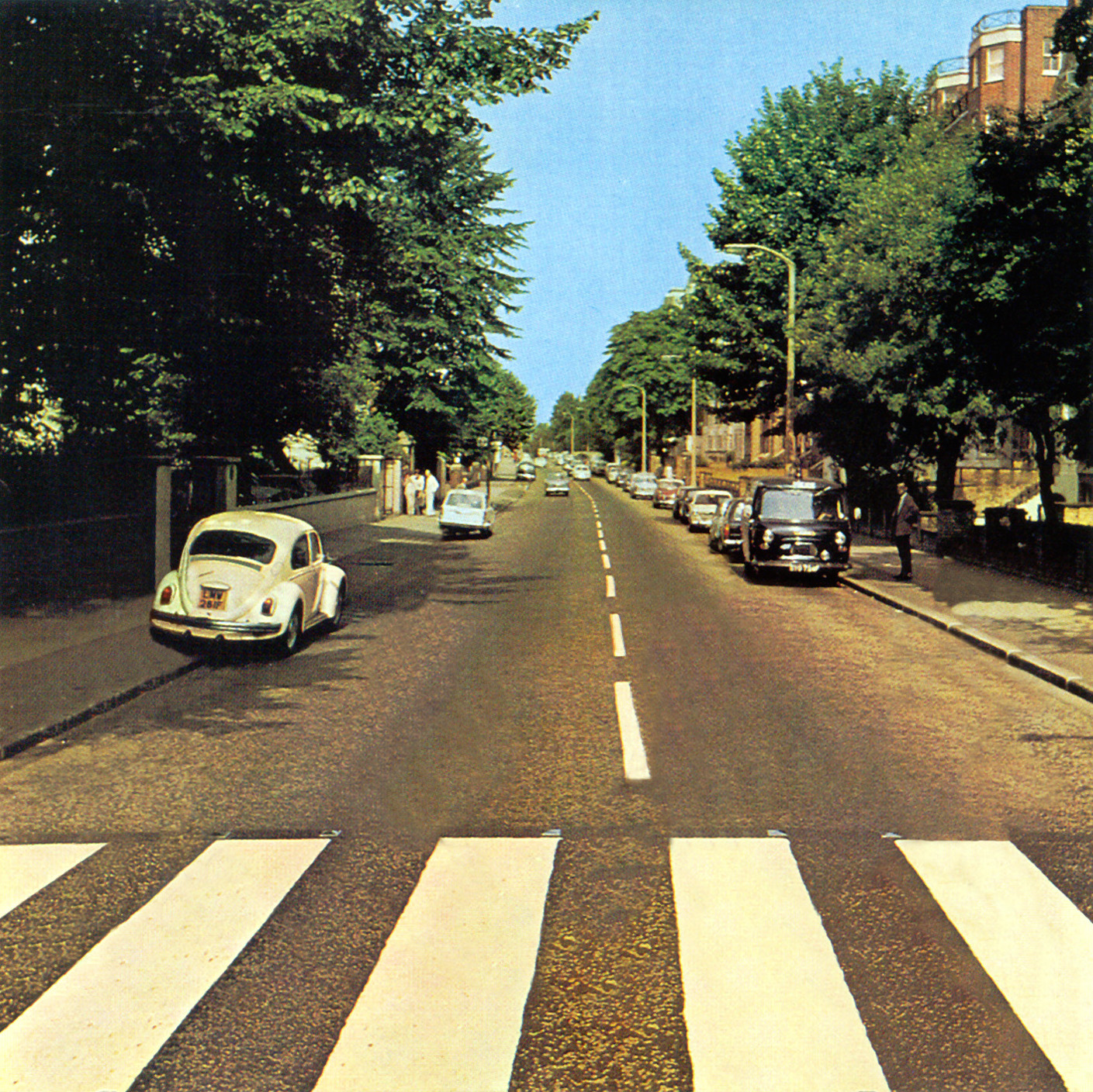
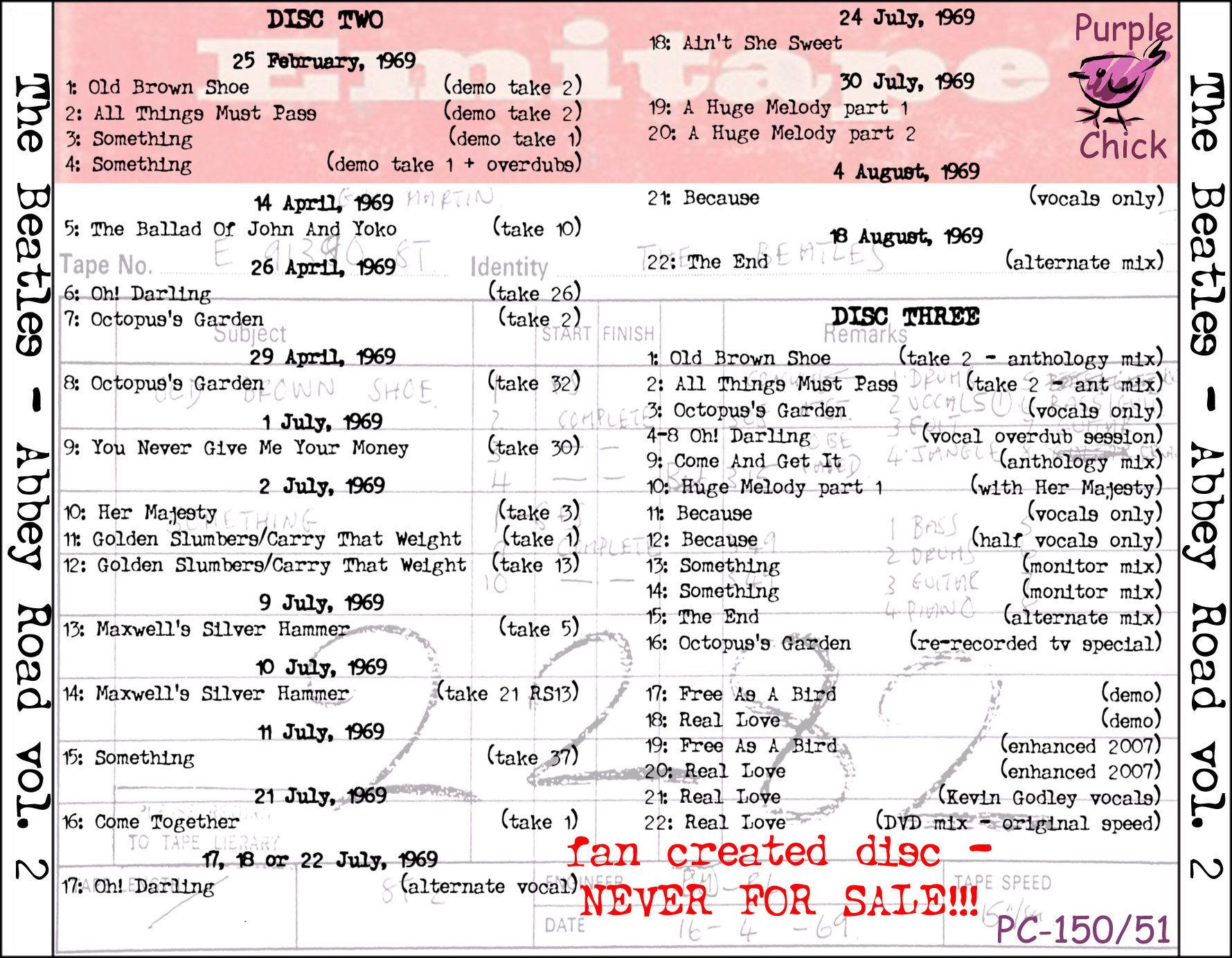
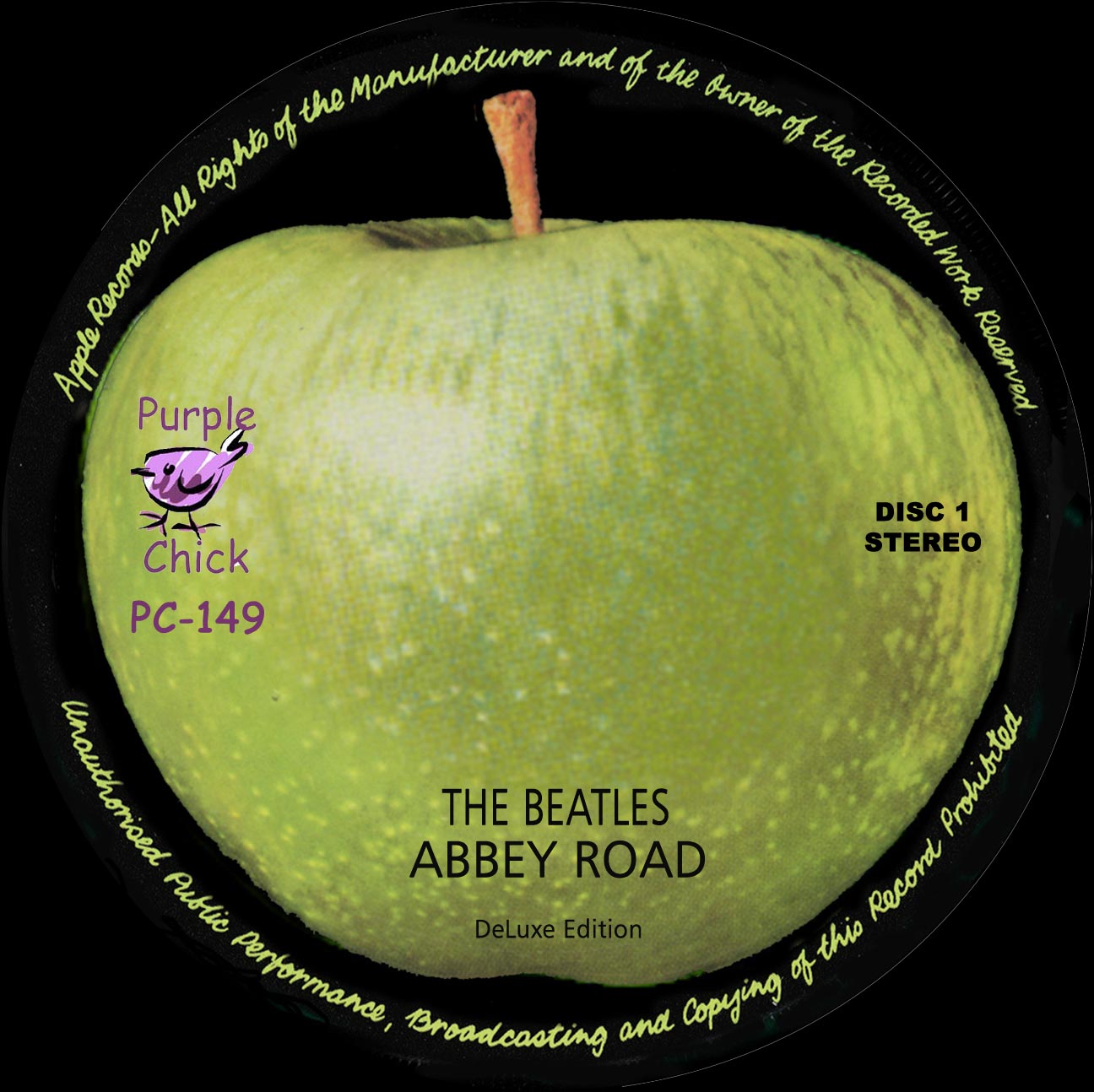
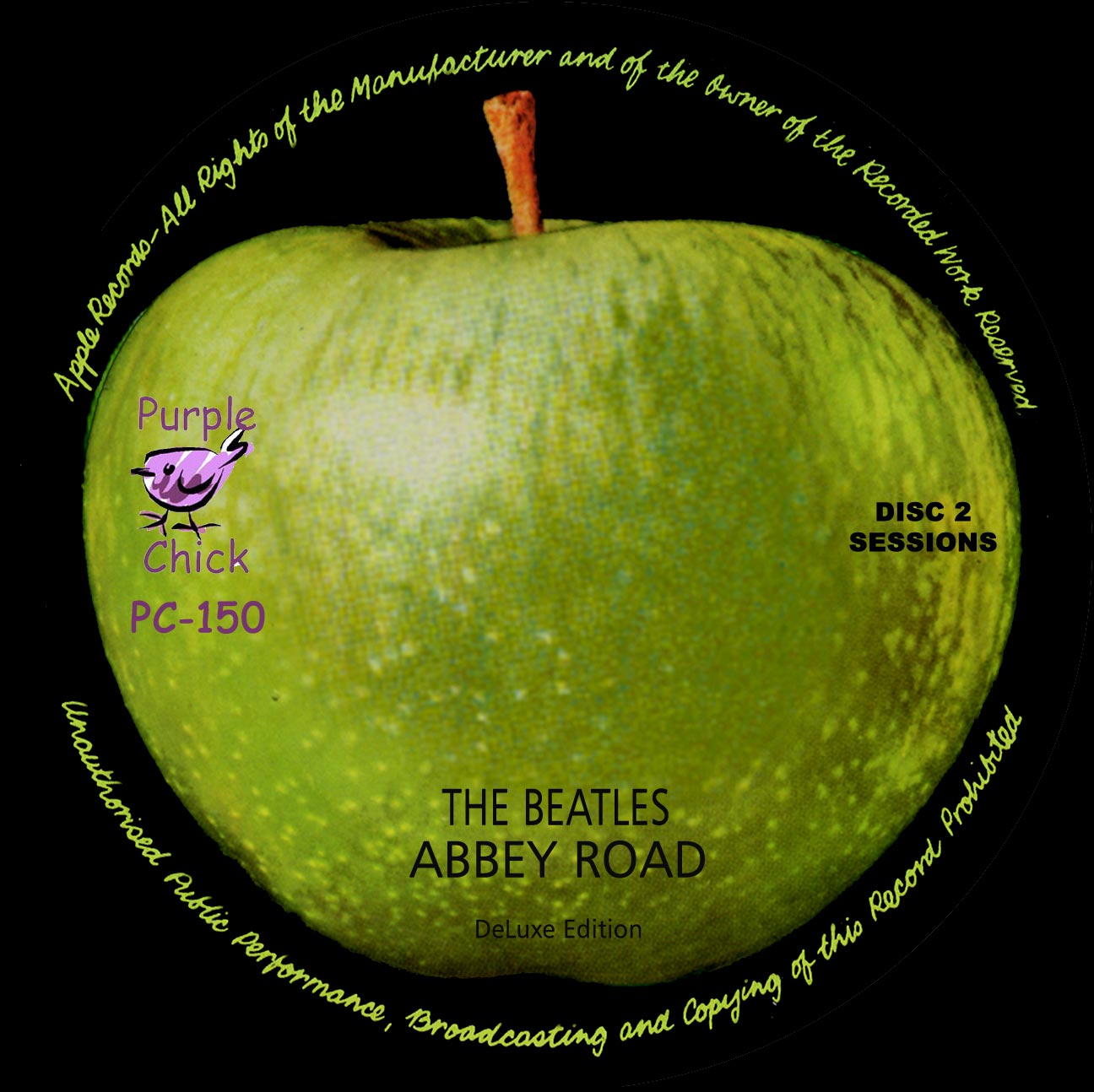
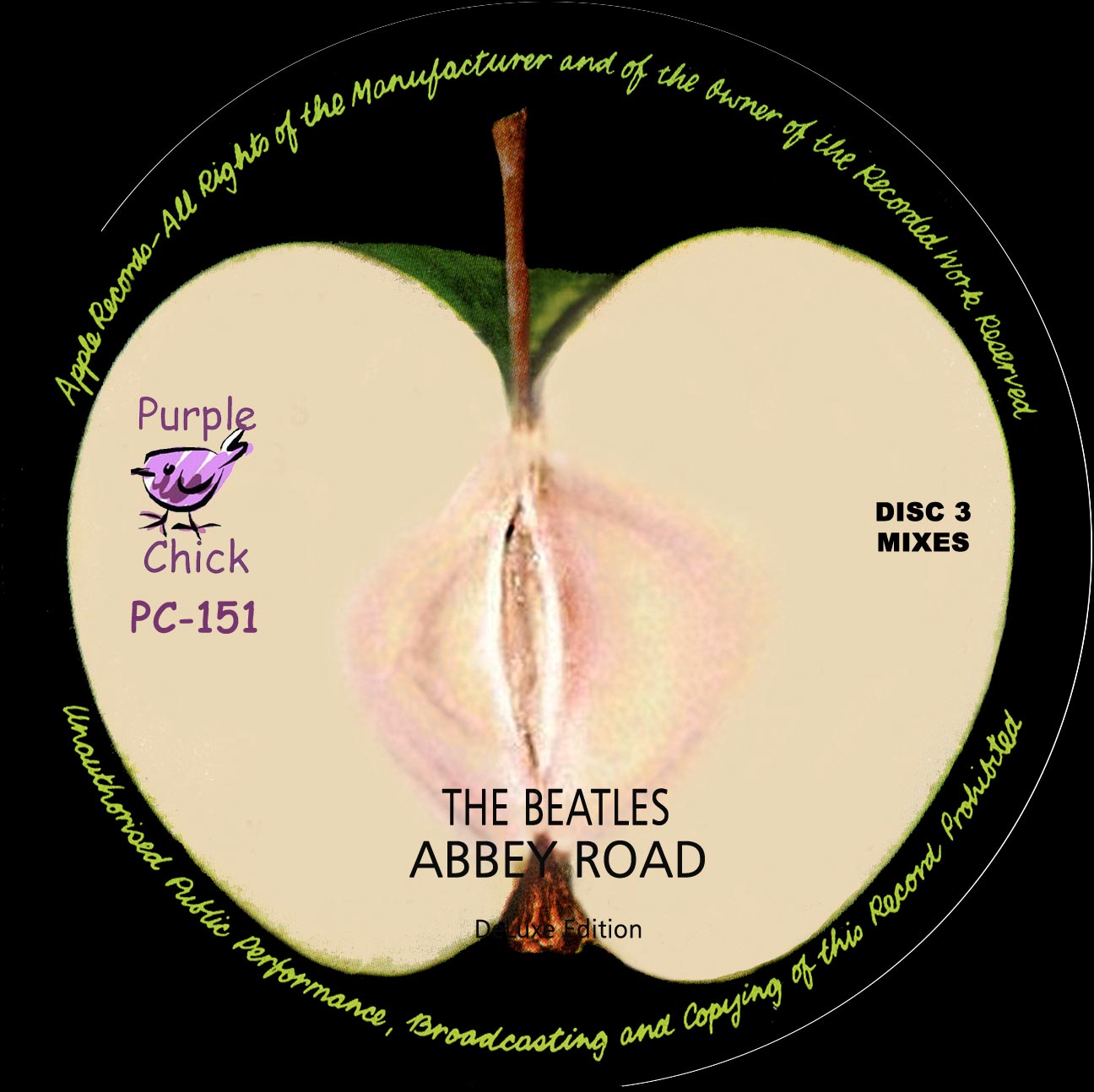
BOOKLET
=================
Abbey Road: Notes
=================
Lineage: SilverCDs–> EAC(secure)–> Flac–> Demonoid
.. contents::
Purple Chick’s Deluxe Edition of Abbey Road is three discs of material covering most of 1969 (plus some “surprise” sessions in the 1990s). This set is three discs long — the shortest since Revolver — due to the lack of dedicated mono mixes of any of the songs (although the Let It Be LP was only released in stereo, several of the songs on it were mixed to mono from the multitrack tapes for the film’s soundtrack). Disc 1 consists of the released tracks from this era, plus one finished but unreleased recording and a
handful of alternate stereo mixes. Discs 2 and 3 are session outtakes plus a few more alternate mixes.
Volume One: The Masters And The Mixes
————————————-
Disc 1
……
Disc 1 kicks off with the second single of 1969, The Ballad Of John And Yoko / Old Brown Shoe. John’s wedding narrative was mixed into stereo immediately after being recorded and was the first Beatles single to have no mono mix. (Get Back / Don’t Let Me Down was stereo-only in the United States, but still mixed and released into mono for the UK. Interestingly enough, this first stereo-only single was mixed only ten days after the mono mixes for the Get Back single were prepared on April 4, 1969.)
This is followed by 17 tracks from the Abbey Road LP, taken (as usual) from Dr. Ebbetts’ transfer of the Blue Box Remaster vinyl. This includes the third and final single of 1969 (and first to give George an A-side), Something / Come Together.
Track 20, Come And Get It, was recorded by Paul as a demo for the Apple-signed group Badfinger. No other Beatles appear, but the song is complete (and was copied nearly note-for-note by Badfinger) and is included here in a stereo mix (the Anthology 3 sorta-stereo mix is on Disc 3).
Although Abbey Road was the last album recorded by the Beatles and Let It Be the last one released, Paul, George and Ringo got back together in the mid-1990s to record overdubs to at least four of John’s demos from the late 1970s. Two would be finished: Free As A Bird and Real Love, and are presented as the next two tracks on this Deluxe Edition.
The disc is rounded out with alternate mixes of some of the songs (more are on Disc 3). Track 23 is The Ballad Of John And Yoko and track 24 is Something, both edited together from their respective 1969 mixes and the mixes used on the Anthology DVD. Track 25 is the customary medley of incomplete Anthology DVD mixes, while track 26 is the Anthology DVD mix of Free As A Bird (the alternate mix of Real Love is on Disc 3).
Abbey Road has the distinction of being the first Beatles album to be released on CD, in Japan in 1983 by Toshiba-EMI. Toshiba-EMI had previously obtained the rights to publish an audiophile mastering of Abbey Road on vinyl in their Pro-Use series and at the time believed they also had the rights to release it on CD. Their parent company EMI informed them otherwise, and the release was pulled off the shelves, but not before several thousand copies got out — so while it’s expensive it’s not impossible to find. It’s also shared online quite a bit, but one should be aware that the original disc was mastered with pre-emphasis which needs to be enabled on each track when burning to a CD-R so that the de-emphasis is properly applied when played back on a CD player. Alternatively, programs like `SoX <http://sox.sourceforge.net/>`_ can digitally reverse the effect — otherwise the tracks will sound overly bright when played back.
Like Let It Be, Abbey Road was not released in mono, but that hasn’t stopped people from trying. The album was released in Brazil in mono as a fold-in of the stereo album (I haven’t been able to determine if they were far behind other countries in switching to stereo, or if their disc mastering equipment was only setup for mono, or both) and Dr. Ebbetts has transferred this copy for us. Mirror Spock has also made a mono Abbey Road, this time by digitally extracting elements from the stereo mixes and “remixing” them into a new mono mix (although I haven’t listened carefully enough to tell what the differences are between it and the Brazilian mono).
Volume Two: Sessions
——————–
Disc 2
……
George celebrated his 26th birthday on February 25, 1969 by recording demos for three recently-written songs onto tape E90644: Old Brown Shoe (track 1), All Things Must Pass (track 2) and Something (track 3). The first would go on to be the flip side to the Beatles’ next single, the second saved for George’s first solo album (for which it would also provide the title) and the third for Abbey Road. Track 4 is the same take of Something taken from an acetate and including a piano overdub.
Calling upon Paul’s help to record the recently-written The Ballad Of John And Yoko, half of the Beatles entered the studio on April 14. With Ringo filming The Magic Christian with Peter Sellers and George shopping for a new house, Paul played drums on the backing track while John provided acoustic guitar and simultaneous vocals to tape E91380. Take ten turned out to be the best so in a series of overdubs the two Beatles added the rest of the instrumentation to the track. Track 5 presents part of this take solely consisting of John’s vocal (with echo) and acoustic guitar. (This is probably taken from the centre channel of the Anthology DVD’s 5.1 surround mix. John’s humming in the place of the “Lonesome Tears In My Eyes” riff near the end is barely audible in the released stereo mix on Disc 1.) Before the end of the session the song had been mixed to stereo and within a few days would be joined by Old Brown Shoe to become the group’s next single (Get Back / Don’t Let Me Down had only just been released on the 11th).
Track 6 is take 26 of Oh! Darling, first recorded on April 20 onto tape E91360. This is a mix made sometime on or after April 26 when Paul first attempted his vocal overdub and could be a mono fold-in of RS4 from May 1. Paul would make several tries at the lead vocal — one a day in an effort to get the rough sound he wanted from his voice. Some of these overdubs have survived and appear as tracks 4 to 8 on Disc 3. He finally achieved his goal on August 11 and those vocals would go onto the master recording (on Disc
1).
Also on April 26 the Beatles started work on Ringo’s second solo composition, Octopus’ Garden. Track 7 is take 2 (from tape E91351). Ringo sings a guide vocal while playing the drums (and repeats the verse and chorus three times). The “superb” line at the end was flown in from take 8 (on the same tape) for this mix on Anthology 3. Take 32 would be the best take of this song, and would have full vocals from Ringo added on April 29. Track 8 represents the song at this point, likely a mono fold-in of mix RS4.
This is from tape E91353. The song would ultimately be mixed for stereo on July 18; seven mono mixes were also made this day — the only mono mixes made for the whole Abbey road album — for an unknown purpose.
You Never Give Me Your Money was started on May 6 at Olympic Studios and 36 takes were recorded to tapes E94067, E94068 and E94069. Sometime during June (while all four Beatles were on holidays) take 30 was cut out or copied to tape E92833 at EMI Studios, and on July 1 Paul added his lead vocal. (And John ran his car off the road, resulting in minor injuries to him and Yoko. He was absent for this session and several more afterwards to spend time at her side while she recovered in the hospital). Track 9 is a rough mix (in mono) showing the state of the song on the 1st. There’s a jam at the end instead of the “all good children” chant which would be recorded later in July.
Paul arrived early on July 2 and recorded a song that he had written the previous autumn and played at least twice during the Get Back sessions in January: Her Majesty. Unable to add anything else to the song, he recorded what he had in three takes to tape E92839 in what was essentially a twintrack recording — his vocals were on one track and acoustic guitar on a second. Track 10 is a rough mix of this song (bootlegged in mono) and includes the final chord that was cut out of the released version.
Ringo and George arrived after Paul finished Her Majesty, and work commenced on the prearranged medley of Golden Slumbers / Carry That Weight — reflecting the sound of You Never Give Me Your Money. Fifteen takes were recorded to tape E92839, the first of which was listened to by Paul, George, Ringo and George Martin during the Anthology documentary, and their commentary (including trying to figure out who played what instrument) is included as track 11. The best was take 13 which was later edited with take
15 and bounced to takes 16 and 17, the latter of which had overdubs added to it beginning the next day. Track 12 is take 13, showing the state of the song as of July 2, and an off-mike vocal from George is audible at several points during the song.
More work was performed on Golden Slumbers / Carry That Weight during the first week of July, as well as nearly completing George’s last Beatles composition, Here Comes The Sun. But the next track to become available to us is take 5 of Maxwell’s Silver Hammer, recorded July 9 onto tape E92826 with some nonsense lyrics from Paul filling out unfinished parts of the song. John also made his return to the studio this day, along with Yoko and a double bed for her continued recovery from the car accident earlier in the month.
Take 21 of Maxwell’s Silver Hammer would turn out to be the best and have overdubs recorded the next day (it managed to fit onto tape E92826 as takes 6 to 10 were skipped). Once this was done, 13 stereo mixes were made capturing the song as it was on July 10. The last of these was copied in mono and appears here as track 14.
Further work was done to Maxwell’s Silver Hammer on the 11th before attention was returned to Something, begun in May. George laid down a lead vocal (manually double tracked) on take 36, filling tape E91419 so it was reduced to take 37 on tape E92830. The vocals would be re-recorded (again onto take 36) later in the week and new reductions made (takes 38 and 39), so track 15 is the only place to hear George’s July 11 vocals.
Sessions for John’s Come Together began at 2:30pm on July 21. Not only did Neil Armstrong and Buzz Aldrin take their first steps on the moon just 12 hours earlier, but Geoff Emerick returned to EMI as a freelance engineer this day (after leaving a few weeks earlier to work for Apple). Track 16 is take 1, recorded to four-track tape E92963 — presumably EMI’s two eight-track decks were already in use this day. An eight-track deck became available later in the day, as the best take (6) was dubbed over to
eight-track tape E92830 in the evening.
Track 17 is a composite of one of Paul’s vocal overdubs to Oh! Darling with the music from the released track (isolated using “Purple Chick Magic”(TM)). The vocals can be heard in isolation as tracks 4 through 8 on Disc 3 (and more information on them can be found in the notes below).
Sometime during the session on July 24 for the second medley, Sun King / Mean Mr. Mustard, the Beatles slipped into a jam including Gene Vincent’s Ain’t She Sweet. This was recorded by the Beatles in Hamburg on June 24 1961 as part of Tony Sheridan’s backing band, but this recording more accurately reflects Vincent’s own recording (rather than the faster arrangement they used in 1961). In a Gene Vincent mood, they continued with Who Slapped John? and Be-Bop-A-Lula. All three songs would have made nice additions to Get Back — that is, if they had been recorded six months earlier … these were not noted on the tape boxes but are on either E94227 or E94229. Ain’t She Sweet was mixed for stereo for Anthology 3 and included here as track 18.
With The End being recorded (as an instrumental and essentially a jam) on July 23 and third medley Polythene Pam / She Came In Through The Bathroom Window started on the 25th (then overdubbed on the 28th and finished on the 30th) there was enough material to produce a test mix of the “Huge Melody” that would end the album. This is included in two parts as tracks 19 and 20. An organ is used to link You Never Give Me Your Money with Sun King instead of the sound effects used on the final crossfade and all songs appear in earlier mixes than those used on the album. (The mix of Polythene Pam includes extra comments from John in similar spirit to the “great” that was heard on the final mix. These can be heard in isolated form on bonus track 23, taken from the Love TV special.) Her Majesty had already been removed from the tape by the time this (mono) copy was made; Paul heard the finished result in the studio and asked that the song be removed. The tape operator complied but, reluctant to throw out anything by the Beatles, added a 20 second leader tape and spliced it onto the end of the mix on tape E92938. Later in the day the tape was taken to Apple where it would be cut to acetates. Paul heard the acetate (including Her Majesty at the end) and liked the effect so much that the song was once more spliced from the reel and added to the master tape for the album in the same spot (including the final chord from the rough mix of Mean Mr. Mustard but lacking its own final chord).
Track 21 is an Anthology 3 mix of just the vocals of Because. These were triple-tracked by John, Paul and George, resulting in a nine-voice choir. A similar bootleg mix appears as track 11 on Disc 3, but this mix avoids instrumental leakage (through the singers’ headphones) by fading out to silence in-between each line.
The End would finally have vocals added to take 7 on tape E92966 in early August (the main lyric on the 5th and “love you” chant on the 7th) and guitar on the 7th (consisting of two bars each from Paul, George and John in order). On the 8th the Beatles crossed the road for the cameras, then recorded additional drums and bass. The orchestral overdubs for every song on the album, including The End, were recorded on August 15 (using, for the first time, a closed-circuit TV hookup between Studios 1 and 2 at EMI). A
wee bit of piano was added just before the main lyric on the 18th. The song was mixed to stereo the next day, revealing that the orchestra was slightly out of sync at the end — this can be heard on track 22 (which also includes guitar and other material that had been mixed out of the final release, hence the “faders up” designation). As a result, the orchestra was copied over to a four-track tape and carefully synchronised with the master eight-track tape when they were mixed (the same method ultimately used for A
Day In The Life), achieving the result on the fourth try. However, it was decided to extend the length of the song by editing in a guitarless mix (with panned vocals to hide the fact that some of them were repeated). Part of this was later removed, resulting in what we hear as track 18 on Disc 1. The edits result in the following:
* 0:35 – 0:47 (bar 1 through bar 6 of the solo)
* 0:47 – 0:53 (bar 9 through the fifth 8th note of bar 12 — bars 7 and 8
were edited out)
* 0:53 – 1:29 (sixth 8th note of bar 4 through bar 22)
Disc 3
……
Disc 3 begins with a couple of alternate mixes of material that has already appeared on Discs 1 and 2. Old Brown Shoe (track 1) and All Things Must Pass (track 2) are Anthology 3 mixes of these songs.
In December a TV special highlighting George Martin was recorded and titled With A Little Help From My Friends. Ringo agreed to perform to a pre-recorded take of Octopus’ Garden, featuring drums and rhythm guitar along with some of the vocals and bubble sound effects from the recording heard on Abbey road. In ten takes a new lead vocal was recorded to the original backing with new lead guitar, piano and bass from unknown session musicians. The result was mixed into a twintrack-style stereo mix (track 16) with
instruments on one side and Ringo’s vocals on the other, allowing them to be isolated (track 3).
The vocals for Oh! Darling were recorded using tape echo (used partially on the final mix), which uses a second tape deck with its record and playback heads placed some distance apart, resulting in a delay in whatever’s recorded to it. Routing the playback head back to the record head with less volume gives an echo effect. In this case someone managed to keep a copy of the tape used in the tape-delay machine, so we ended up with a copy of one of Paul’s vocal overdubs from either July 17, 18 or 22. (Each overdub would have been erased from the master tape every time a new one was recorded. The vocals on the released version were recorded on July 23.) Track 4 is mostly
of Paul repeating lines and goofing around trying to get the level of echo right. He has some fun with the effect around a minute into track 5, then complains about his headphones being disconnected before trying some yodeling. The song finally begins at the start of track 7 but cuts out before the end. Track 8 is the first 20 seconds of this tape, running at the original speed(s) (the tape speed was adjusted during recording to alter the delay of the echo).
Due to the proximity of his home to EMI Studios, Paul would frequently be the first to arrive. He did so on July 24 and recorded in one take onto tape E94227 a demo of Come And Get It for Apple-signed group Badfinger (formerly The Iveys) who would record the song as a hit single and as part of the soundtrack for Ringo and Peter Sellers’ film The Magic Christian. As Paul added overdubs, John gave advice from the control room (so I guess it counts as a Beatles recording and not a solo Paul recording). The song was finished in an hour before George and Ringo arrived and is heard here as track 9 (using the fake stereo mix made by Geoff Emerick for Sessions and appearing on Anthology 3) and on Disc 1 (track 20, in a true stereo mix made just after the song was recorded). On August 2, Paul would produce Badfinger’s version of the song — nearly identical to his own but running slightly faster.
Track 10 is the first part of the “Huge Melody” with Her Majesty inserted into its original location between Mean Mr. Mustard and Polythene Pam — as it would have sounded when first played for the Beatles on July 30.
Track 11 is a mix of Because consisting solely of the vocals (which was duplicated officially for Anthology 3 and appearing on Disc 2). Track 12 is a mix prepared for the Abbey Road Video Show in 1983 that has one minute of vocals-only crossfaded with a full mix (including George’s Moog synthesizer) for the remainder of the song (it sounds pretty cool when the instruments first come in).
Tracks 13 and 14 are monitor mixes of Something (probably takes 36 and 39), made in 2003 during a demonstration by Peter Cobbin on how he mixed this song into surround sound for the then-upcoming Anthology DVD release. This aired on CNN: The Music Room sometime around May 1, 2003 and gives some insight on both the recording and mastering of the song.
Track 15 seems to be an outfake of The End created by cutting out around twenty seconds of material starting around the 50 minute mark from the master recording. (That is, there doesn’t seem to be anything here that isn’t on the original recording).
The four Beatles were together in the studio for the last time on August 20 1969 in order to mix and determine the running order for Abbey Road. Three of them were present for two final sessions on January 3 and 4 1970 for Let It Be, and both George and Ringo would appear to help finish that album up until April 1 of that year. Although they formally disbanded on April 10 1970 in the midst of a lawsuit, they would individually appear on several of each other’s solo recordings (including an unreleased session during John’s “Lost Weekend” in 1974 featuring both him and Paul) and despite their differences would still associate personally (and professionally at Apple Corps. meetings well into the 1970s). Promoters offered millions of dollars for a Beatles reunion (Lorne Michaels mocked these in 1976 by offering $3000.00 for them to appear on Saturday Night Live — Paul and John were watching the show together and nearly accepted “as a gag”), but all hopes of a reunion were dashed on December 8 1980 when John Lennon was assassinated.
But it was not The End.
The Beatles and their heirs had been involved with lawsuits with EMI at least until 1989. EMI’s “Sessions” project was revived as “Anthology” and by 1993 or 1994 it was decided it needed something new on it. In January 1994, Paul inducted John into the Rock And Roll Hall Of Fame and Yoko used the opportunity to present Paul with one or more cassette tapes of demos that John had made. John had been recording these demos on a portable cassette tape recorder throughout the 1970s up until a few weeks before his death, and had a wealth of unreleased songs. The three Beatles entrusted the tapes to George’s fellow Traveling Wilbury Jeff Lynne (George Martin declined productions duties due to hearing loss), who used a digital audio workstation to remove noise from the rough demo of Free As A Bird (track 17) and attempt to separate John’s voice from the instruments and place them on 48-track analogue tape in a form suitable for overdubbing. The overdubs began on February 11 1994 (coincidentally 31 years to the day of their marathon session recording most of their first album Please Please Me) at Paul’s studio “The Mill” in Sussex. By the end of the day they had finished Free As A Bird (the result being track 21 on Disc 1).
After a less successful attempt at finishing John’s demo of Now And Then on June 22 1994 (and a session at George’s recording studio the next day at which allegedly ten hours of mostly oldies were recorded), the three Beatles reconvened at The Mill Studio on February 6 and 7 1995 to record Real Love (the demo of which is track 18). Not only was the introduction played on the same celeste used by John on Because, but the harmonium was the same one used on several Beatles tracks including We Can Work It Out (both
instruments had been purchased by Paul in the intervening years). The Anthology project now in full swing, these two sessions were videotaped in order to produce a promotional video for the song. Due to the secrecy of the sessions, video co-director (and former 10cc member) Kevin Godley was only given a partially-completed take of the song, so in order to edit the video he dubbed his own vocals (this variant is heard as track 21). Two final sessions on the 15th and 16th of May 1995 finished Real Love (heard as track 22 on Disc 1). The final track is sped up by a semitone (giving Kevin Godley some problems when editing the video) — track 22 is a mix made at the original speed for the Anthology DVD.
Tracks 19 and 20 are the two reunion tracks enhanced by Purple Chick to emphasise John’s contributions by dubbing in more of his demos.
Bibliography
————
The Beatles Deluxe Editions By Purple Chick
http://x3mkungen.mine.nu/wogev/beatles/pc/index.html
The Beatles Recording Sessions Update
http://reunionsessions.tripod.com/al/faabsessions/contents.html
The BeatleSource
http://www.beatlesource.com/
BootlegZone
http://www.bootlegzone.com/
Brennan, Joe. The Usenet Guide to Beatles Recording Variations
http://www.columbia.edu/~brennan/beatles/
CNN.com – Behind The Scenes: “The Beatles Anthology”
http://edition.cnn.com/2003/SHOWBIZ/Music/05/01/mroom.beatles.anthology/index.html
The Internet Beatles Album
http://www.beatlesagain.com/
Lewisohn, Mark. The Beatles Recording Sessions
Lewisohn, Mark. The Complete Beatles Chronicle
Ryan, Kevin and Kehew, Brian. Recording The Beatles
Wikipedia
http://en.wikipedia.org/wiki/The_Beatles
Winn, John C. (ed.). John Barrett’s Notes
Winn, John C. The Beatles Recorded Legacy
http://members.aol.com/multiplusbooks/
* Volume One: 1957-1965 (Way Beyond Compare)
* Volume Two: 1966-1970 (That Magic Feeling)
* Volume Three: Inside The Beatles Vaults (Lifting Latches)
